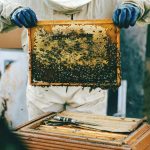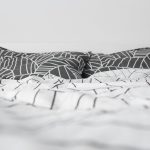You can use polycotton safely for a face mask since it combines cotton’s softness with polyester’s durability, offering good breathability and comfort. Polycotton masks provide better filtration than pure polyester and are effective against larger droplets while allowing airflow to prevent overheating. They dry quickly and resist wrinkles, making them practical for everyday wear. While some people might be sensitive to polyester, polycotton balances comfort and protection well. Keep exploring to understand how it compares to other fabrics and best care practices.
Table of Contents
Key Takeaways
- Polycotton masks offer effective filtration, blocking 60-80% of particles, balancing protection and comfort for everyday use.
- The fabric blend ensures good breathability and moisture-wicking, preventing overheating and dampness during prolonged wear.
- Polycotton is soft and gentle on skin, but polyester may cause irritation for sensitive individuals, so hypoallergenic options are preferred.
- The material is durable, wrinkle-resistant, and maintains shape, extending mask lifespan with proper care and washing.
- Polycotton masks provide a practical balance of safety, comfort, and environmental impact compared to pure cotton or polyester masks.
Understanding Polycotton Fabric Composition
Polycotton blends cotton and polyester fibers to combine the best qualities of both materials. When you choose polycotton, you’re getting the softness and breathability of cotton paired with the durability and wrinkle resistance of polyester.
Typically, the fabric composition varies—common blends include 65% polyester and 35% cotton or a 50/50 mix. This balance influences the fabric’s feel, strength, and moisture-wicking ability. You’ll notice polycotton is less prone to shrinking compared to pure cotton, making it easier to care for.
Plus, the polyester component enhances quick drying and shape retention. Understanding this composition helps you appreciate why polycotton suits applications needing comfort and resilience, like face masks, without sacrificing ease of use or maintenance.
The Role of Fabric in Face Mask Effectiveness
When choosing a face mask, you need to balance filtration capabilities with breathability to stay comfortable and protected.
The fabric’s weave and material directly impact how well it blocks particles without making it hard to breathe.
Understanding this trade-off helps you pick the right mask for your needs.
Fabric Filtration Capabilities
Anyone choosing a face mask should understand how fabric affects filtration efficiency. Different materials capture particles differently, which impacts your protection level. Polycotton blends combine the filtration properties of cotton with synthetic fibers, potentially improving particle blockage.
Here’s a quick look at common fabrics and their filtration capabilities:
| Fabric Type | Filtration Efficiency (%) |
|---|---|
| 100% Cotton | 50-70 |
| Polycotton Blend | 60-80 |
| Polyester | 40-60 |
| Silk | 50-65 |
Polycotton’s mixed fibers offer a balance, filtering more than polyester alone but less than tightly woven cotton. When selecting a mask, consider this filtration factor to guarantee you get adequate protection.
Breathability Versus Protection
Balancing filtration efficiency with breathability can be challenging when choosing a face mask fabric. You want a mask that filters out particles effectively but also lets you breathe comfortably.
Polycotton offers a decent middle ground—its blend of polyester and cotton fibers provides good filtration without restricting airflow too much. If the fabric is too dense, you’ll struggle to breathe, making the mask uncomfortable and less likely to be worn consistently.
On the other hand, if the fabric is too porous, it won’t protect you well from airborne particles. When selecting or making a mask, consider layering polycotton with other materials to enhance protection while maintaining breathability.
This balance guarantees you stay safe and comfortable throughout the day.
Breathability Features of Polycotton
Polycotton combines the best of polyester and cotton to offer excellent breathability, making it ideal for face masks. When you wear a polycotton mask, you’ll notice it allows air to flow while still feeling soft against your skin.
Here’s why it stands out:
- Moisture Wicking: Polycotton quickly draws moisture away, keeping you comfortable during long wear.
- Lightweight Fabric: The blend creates a light texture that prevents overheating.
- Durable Weave: Its tight yet breathable weave balances airflow without sacrificing comfort.
Filtration Efficiency of Polycotton Masks
When choosing a mask, you’ll want to take into account how well polycotton filters particles compared to other fabrics.
The fabric’s thread count plays a big role in its filtration efficiency, affecting how much it can block.
Let’s look at how polycotton stacks up and what that means for your protection.
Filtration Capabilities Overview
Although synthetic and natural fibers each offer unique benefits, polycotton blends combine their strengths to provide effective filtration in face masks. When you choose polycotton, you get a balance of comfort and protection.
Here’s what makes polycotton masks effective:
- Multi-layer Filtration: Polycotton’s weave allows multiple layers to trap particles efficiently without heavy bulk.
- Electrostatic Properties: The cotton fibers hold a mild static charge that helps capture tiny particles, enhancing filtration.
- Breathability Balance: Its blend maintains airflow, so you can breathe easier without sacrificing safety.
You’ll find polycotton masks perform well in filtering larger droplets and some smaller aerosols, making them a practical choice for everyday use.
Comparison With Other Fabrics
While many fabrics offer different levels of protection, you’ll find that polycotton masks strike a reliable balance between filtration efficiency and comfort.
Compared to 100% cotton, polycotton often filters out more particles because the synthetic fibers help trap smaller droplets. It doesn’t match the high filtration of materials like polypropylene or specialized filter fabrics, but it performs better than loosely woven cotton or silk.
When paired with multiple layers, polycotton can greatly improve protection without sacrificing breathability, making it a practical everyday option.
You’ll also notice it’s more durable and wrinkle-resistant than pure cotton, which means your mask maintains its protective qualities longer.
Impact of Thread Count
You’ve seen how polycotton offers a solid mix of comfort and filtration compared to other fabrics.
The thread count plays a significant role in how well your polycotton mask filters particles. Higher thread counts generally mean tighter weaves, which improve filtration but might reduce breathability.
When choosing or making a polycotton mask, consider these factors:
- Thread count range: Aim for 180-220 threads per inch for a balance between filtration and comfort.
- Weave tightness: A tighter weave blocks smaller particles more effectively.
- Layering: Multiple layers of polycotton with moderate thread counts can enhance filtration without sacrificing breathability.
Comparing Polycotton to 100% Cotton Masks
When choosing between polycotton and 100% cotton masks, you’ll notice differences in comfort, durability, and filtration. Polycotton blends synthetic and natural fibers, offering better moisture-wicking and shape retention, while pure cotton provides excellent breathability and softness. Your choice depends on balancing these factors for daily use.
| Feature | Polycotton | 100% Cotton |
|---|---|---|
| Breathability | Moderate, slightly less | High, very breathable |
| Filtration | Good, synthetic fibers add | Good, depends on weave |
| Comfort | Smooth, less prone to wrinkling | Soft, natural feel |
| Moisture Handling | Dries quicker | Absorbs more moisture |
Both mask types serve well, but polycotton might suit you if you want durability with decent comfort.
Durability and Maintenance of Polycotton Masks
Choosing polycotton masks means you’ll benefit from their sturdy blend of fibers, which enhances durability compared to 100% cotton options.
This resilience lets you use your mask longer without worrying about wear and tear. To keep your polycotton mask in top shape, follow these key maintenance tips:
- Wash regularly with mild detergent in warm water to remove dirt and germs without damaging fibers.
- Avoid high heat drying; opt for air drying or low heat to prevent shrinkage and fiber breakdown.
- Inspect seams and elastic bands often to catch any signs of wear early and extend the mask’s lifespan.
Comfort Factors When Wearing Polycotton Masks
You’ll notice that polycotton masks feel soft against your skin, making them comfortable for long wear.
They also wick moisture away, helping you stay dry throughout the day.
Plus, their temperature regulation keeps you cool when it’s warm and cozy when it’s cold.
Softness and Skin Feel
Softness plays an essential role in how comfortable a polycotton mask feels against your skin. When you wear a mask for extended periods, you want a fabric that won’t irritate or cause discomfort.
Polycotton blends balance the softness of cotton with the durability of polyester, making it gentle yet resilient.
Here’s what you should consider about softness and skin feel:
- Fabric weave: Tighter weaves tend to feel smoother and softer against your skin.
- Blend ratio: Higher cotton content usually means a softer texture.
- Finishing treatments: Some polycotton fabrics undergo special treatments to enhance softness without sacrificing breathability.
Moisture Wicking Ability
Three key factors affect how well a polycotton mask handles moisture: fabric composition, weave, and finishing.
Since polycotton blends cotton’s absorbency with polyester’s quick-drying traits, you get a balanced moisture-wicking ability. The tighter the weave, the less moisture passes through, but it might reduce breathability.
Finishing treatments can enhance moisture dispersion, helping sweat evaporate faster. When you wear a polycotton mask, it won’t soak up sweat like pure cotton, which keeps the fabric feeling lighter and less damp.
This means your mask stays more comfortable during extended use, reducing irritation or odor buildup.
However, not all polycotton masks perform the same, so check the product details or reviews to ascertain good moisture management before you buy.
Temperature Regulation Properties
Although polycotton masks combine different fibers, they still manage to regulate temperature effectively, keeping you comfortable throughout the day. When you wear a polycotton mask, you’ll notice it balances warmth and breathability well, preventing overheating or chills.
Here’s why it works for temperature control:
- Blend Advantage: Cotton fibers absorb moisture and cool you down, while polyester adds durability and quick drying, maintaining comfort.
- Airflow: The fabric weave allows sufficient airflow to avoid heat buildup.
- Lightweight Feel: Polycotton masks don’t cling tightly, so you won’t feel stifled when moving or talking.
This temperature regulation means you can wear your mask longer without discomfort, making polycotton a practical choice for everyday use.
Potential Allergic Reactions and Sensitivities
When you choose polycotton for face masks, it’s important to reflect that some people may experience allergic reactions or sensitivities to the fabric blend.
Polycotton combines natural cotton fibers with synthetic polyester, and while cotton is generally hypoallergenic, polyester can sometimes cause skin irritation or itching.
If you have sensitive skin or a history of textile allergies, you might notice redness, rash, or discomfort after wearing a polycotton mask for extended periods.
To minimize risks, look for masks labeled as hypoallergenic or those that use high-quality, skin-friendly dyes and finishes.
Always wash new masks before use to remove any residual chemicals.
If irritation occurs, switch to masks made from 100% natural fibers like organic cotton or consult a dermatologist for advice.
Environmental Impact of Polycotton Masks
Because polycotton blends both natural and synthetic fibers, its environmental impact differs from masks made solely of cotton or polyester.
When you choose a polycotton mask, consider these factors:
- Resource Use: Polycotton requires less water than 100% cotton but still depends on petroleum-based polyester, impacting fossil fuel consumption.
- Durability and Waste: Its strength means polycotton masks often last longer, reducing how often you replace them and lowering overall waste.
- Biodegradability: Unlike cotton, the synthetic portion slows decomposition, so discarded polycotton masks persist longer in landfills.
Best Practices for Making Polycotton Face Masks
To make effective polycotton face masks, you’ll need to focus on selecting the right fabric blend, guaranteeing proper fit, and employing reliable sewing techniques.
Choose a polycotton blend with at least 50% cotton for breathability and comfort. Use tightly woven fabric to improve filtration without sacrificing airflow. Cut multiple layers—two or three—to enhance protection.
When sewing, reinforce seams to prevent gaps and guarantee durability through washing. Design the mask to snugly cover your nose and mouth, adding adjustable ear loops or ties for a secure fit. Incorporate a nose wire if possible to reduce air leakage.
Finally, pre-wash the fabric to reduce shrinkage and remove chemicals. Following these steps will help you create comfortable, safe, and reusable polycotton masks.
Expert Recommendations on Polycotton Mask Usage
After crafting your polycotton mask with care, knowing how to wear and maintain it properly will maximize its effectiveness.
Experts recommend you follow these key steps:
- Wear it snugly: Confirm your mask covers your nose and mouth fully without gaps for better protection.
- Wash regularly: Clean your polycotton mask after each use with hot water and detergent to eliminate germs.
- Replace when needed: If the mask shows signs of wear, thinning, or damage, swap it out to maintain safety.
Frequently Asked Questions
Can Polycotton Masks Be Reused After Washing Multiple Times?
You can reuse polycotton masks after washing, but their effectiveness may decrease over time. Make sure to wash them properly and inspect for wear or damage to maintain safety and breathability before each use.
How Does Polycotton Fabric Handle Moisture Buildup During Extended Wear?
Polycotton handles moisture reasonably well, but it can trap sweat during extended wear. You’ll notice some dampness, so it’s best to take breaks or switch masks to stay comfortable and maintain breathability throughout the day.
Are Polycotton Masks Effective Against Airborne Allergens?
Think of polycotton masks like a window screen—they let air through but block larger particles. You won’t catch every allergen, but they reduce exposure better than no mask, helping you breathe easier outdoors.
What Is the Cost Comparison Between Polycotton and Other Mask Materials?
You’ll find polycotton masks generally cost less than pure cotton or specialized materials like silk. They offer a budget-friendly option without sacrificing comfort, making them a practical choice for everyday mask use.
Do Polycotton Masks Require a Specific Type of Filter Insert?
You don’t necessarily need a specific filter insert for polycotton masks, but using a PM2.5 or surgical filter can boost protection. Make sure the mask has a pocket to hold the filter securely in place.
- Where to Buy Sherpa Suede Fabric - July 12, 2025
- How to Draw or Illustrate the Texture of Suede Fabric - July 12, 2025
- What Is Baseball Suede Leather Fabric? - July 12, 2025







